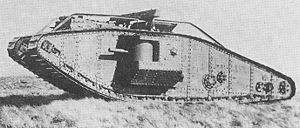Mark VII (tank)
The Mark VII was a British tank of the First World War . It was a further development of the Mark II , from which it differed in a slightly elongated chassis .
One of the Mark II's used as a test vehicle had hydraulic power transmission. In October 1917, a contract was signed with Brown Brothers in Edinburgh to further develop this technology. In July 1918 the prototype was ready. Its propulsion system was very complex. The motor drove the pumps via a variable speed gearbox, which in turn drove two Williams-Janney hydraulic motors. Each of the hydraulic motors drove an armored chain . Because of the obvious risk of overheating , there were plenty of fans, vents, and coolers. The control was simple and only possible in stages. A tank battalion should be equipped with this model.
Three of the 74 copies ordered had been completed by the end of the war.
No Mark VII has survived. Only one of the Mark II remained (see here ).
Others
"Mark VII" was also the name of the most widely used British depth charge in World War II.
